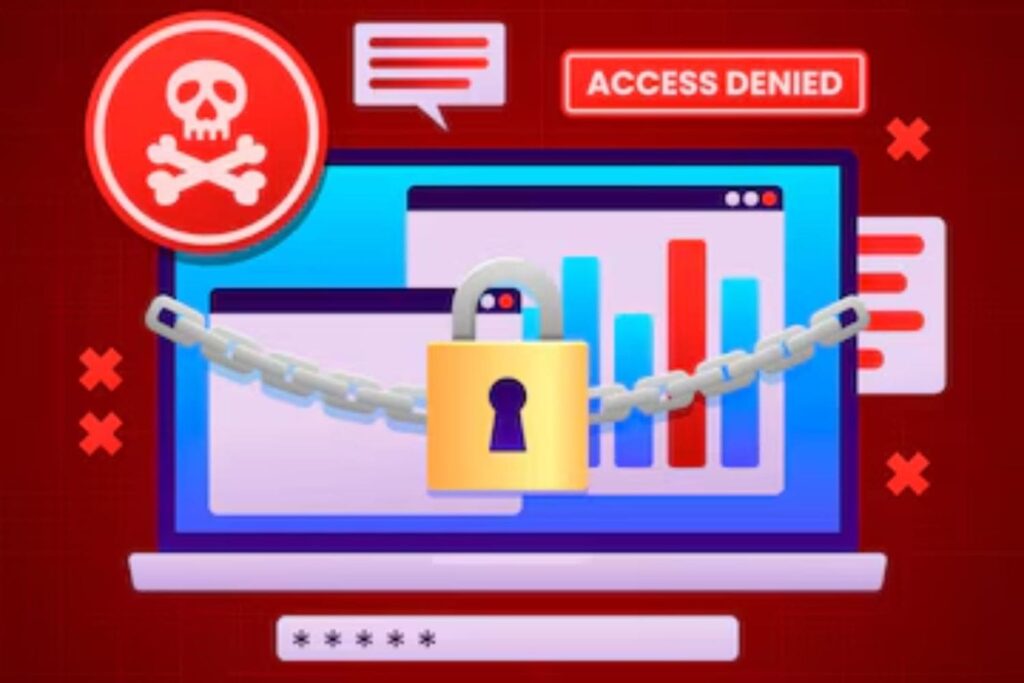
Matrix of All Current Cybersecurity Threats (2025)
What is a threat matrix in cyber security?
A matrix of all current cybersecurity threats is an essential tool for safeguarding digital assets. It provides a structured framework to identify, categorize, and prioritize potential risks. Key aspects include:
- Threat Sources: Identifying internal or external origins of threats.
- Attack Vectors: Highlighting methods like phishing, ransomware, or malware.
- Vulnerabilities: Pinpointing system weaknesses that attackers may exploit.
- Risk Analysis: Assessing threats based on likelihood and impact.
- Resource Allocation: Prioritizing critical risks for effective mitigation.
By using a matrix of all current cybersecurity threats, organizations can stay proactive, address vulnerabilities efficiently, and strengthen overall security measures in an evolving digital landscape.
Matrix of All Current Cybersecurity Threats in 2025
In 2025, the evolving digital landscape brings a matrix of all cybersecurity threats, challenging individuals, businesses, and governments. This guide highlights key risks, real-world examples, and effective strategies to stay protected.
1. Ransomware: A Growing Menace

Ransomware has become one of the most dangerous elements in the matrix of all current cybersecurity threats. Ransomware attacks have evolved from simple data encryption to complex, multi-layered extortion strategies. Cybercriminals not only lock your files but also threaten to publish sensitive information, demanding exorbitant ransoms.
Example: Colonial Pipeline Ransomware Attack (2021)
In this infamous incident, the DarkSide ransomware group targeted the Colonial Pipeline, disrupting fuel supply across the U.S. The company paid $4.4 million in Bitcoin to regain access, highlighting the devastating economic and societal impact of such attacks.
2025 Trends in Ransomware
- Double Extortion: Threats to leak data if the ransom isn’t paid.
- Ransomware-as-a-Service (RaaS): Cybercriminals now offer ransomware tools to others for a cut of the ransom.
How to Defend Against Ransomware
- Regularly back up critical data to secure, offline locations.
- Use advanced endpoint detection and response (EDR) tools.
- Educate employees on phishing emails and suspicious links.
2. Phishing Attacks: The Power of Deception

Phishing remains the most widespread cyber threat, leveraging social engineering to trick users into revealing sensitive information or installing malware.
Example: Google Docs Phishing Campaign (2017)
Attackers sent fake Google Docs invitations, tricking users into granting permissions to malicious third-party apps. This campaign showcased how even trusted platforms could be exploited.
2025 Innovations in Phishing
- AI-Driven Phishing Emails: Cybercriminals use AI to craft highly personalized and convincing phishing attempts.
- Vishing (Voice Phishing): Scammers use AI voice synthesis to mimic trusted individuals, enhancing credibility.
Prevention Strategies
- Train employees to recognize phishing attempts through workshops and simulations.
- Deploy robust email filtering tools.
- Use multi-factor authentication (MFA) to secure accounts.
3. Supply Chain Attacks: Exploiting Third Parties

Supply chain attacks target vulnerabilities in third-party vendors to compromise larger organizations.
Example: SolarWinds Hack (2020)
Hackers inserted malicious code into a routine update for SolarWinds’ Orion software, affecting thousands of organizations, including Fortune 500 companies and U.S. government agencies.
How They Work
Attackers infiltrate trusted vendors, distribute malicious updates, and gain access to the larger networks connected to them.
Defense Mechanisms
- Vet and audit third-party vendors for security compliance.
- Monitor network traffic for unusual activity.
- Segment sensitive data to limit exposure.
4. IoT Vulnerabilities: A Growing Attack Surface

The Internet of Things (IoT) has revolutionized industries but also expanded the cyberattack surface. Poorly secured IoT devices are exploited as entry points into larger systems.
Example: Mirai Botnet (2016)
Hackers hijacked unsecured IoT devices like cameras and routers, creating a massive botnet that launched one of the largest Distributed Denial of Service (DDoS) attacks in history.
2025 Challenges in IoT
- Data Breaches: Attackers exploit IoT devices to steal sensitive user information.
- Botnets for DDoS: Unsecured IoT devices are turned into zombie bots to overwhelm networks.
Protection Tips
- Update IoT device firmware regularly.
- Use strong, unique passwords for all devices.
- Segment IoT devices onto a separate network from critical systems.
5. Advanced Persistent Threats (APTs): The Invisible Adversary

Advanced Persistent Threats (APTs) involve long-term, targeted attacks on high-value targets like governments and critical infrastructure.
Example: Stuxnet (2010)
Believed to be the first cyberweapon, Stuxnet targeted Iran’s nuclear facilities by exploiting vulnerabilities in industrial control systems.
Modern APT Targets
- Intellectual property in the tech sector.
- National infrastructure like power grids and water systems.
Mitigation Strategies
- Employ advanced threat intelligence platforms.
- Monitor unusual network activity in real-time.
- Enforce strict access controls to sensitive systems.
6. AI and Machine Learning Exploits

AI and machine learning have revolutionized cybersecurity defenses, but they also empower cybercriminals to scale attacks and evade detection.
Example: Deepfake CEO Fraud (2022)
Attackers used AI-generated voice technology to impersonate a company’s CEO, convincing employees to transfer $243,000.
2025 Threats from AI
- Automated Attacks: AI-powered bots identify and exploit vulnerabilities at scale.
- Deepfake Technology: Used for impersonation in fraud and disinformation campaigns.
Countermeasures
- Incorporate AI-powered detection systems to counteract AI-driven threats.
- Educate employees about deepfake technology.
- Verify suspicious requests through secondary communication channels.
7. Cloud Security Threats

Cloud computing has become the backbone of modern IT infrastructure, but misconfigurations and weak security practices remain major risks.
Example: Accenture Cloud Leak (2017)
Accenture exposed sensitive client information due to improperly configured Amazon Web Services (AWS) cloud storage.
Emerging Cloud Threats
- Account Hijacking: Weak passwords and phishing enable attackers to gain control of cloud accounts.
- Misconfigured Storage: Improper security settings lead to massive data leaks.
Best Practices for Cloud Security
- Regularly audit cloud configurations for compliance.
- Encrypt sensitive data stored in the cloud.
- Use MFA and strong passwords for all cloud accounts.
8. Insider Threats: Internal Risks

Insider threats stem from current or former employees, contractors, or business associates who misuse access to harm an organization.
Example: Tesla Insider Sabotage (2020)
An employee attempted to sabotage Tesla’s manufacturing operations by leaking sensitive data to competitors.
Types of Insider Threats
- Malicious Insiders: Intentional harm through espionage or sabotage.
- Accidental Insiders: Employees unintentionally exposing systems to attacks.
Defense Strategies
- Limit access based on job roles and responsibilities.
- Use monitoring tools to track unusual activity.
- Regularly update security policies and train employees.
9. Cryptojacking: Silent Resource Theft

Cryptojacking is another major pillar in the matrix of all current cybersecurity threats. Cryptojacking involves using a victim’s computing resources to mine cryptocurrencies without their consent.
Example: Coinhive Exploit (2017)
Hackers embedded cryptojacking scripts into websites, hijacking visitors’ CPUs for mining.
How to Detect Cryptojacking
- Unexplained slowdowns in system performance.
- Overheating devices due to excessive CPU usage.
Prevention Tips
- Install anti-malware tools.
- Monitor resource usage for anomalies.
- Block known cryptojacking scripts using browser extensions.
10. Zero-Day Exploits

Zero-day exploits target software vulnerabilities that are unknown to the vendor, leaving systems defenseless until a patch is developed.
Example: EternalBlue (2017)
This exploit, later weaponized in the WannaCry ransomware attack, targeted an unpatched vulnerability in Windows systems.
How to Protect
- Apply patches and updates as soon as they’re available.
- Use intrusion detection systems (IDS) to identify anomalies.
- Conduct regular security assessments to discover vulnerabilities.
11. Business Email Compromise (BEC)

BEC attacks involve impersonating trusted individuals or entities to manipulate employees into transferring money or sensitive data.
Example: Ubiquiti Networks (2015)
BEC scammers stole $46.7 million by impersonating executives and tricking employees into transferring funds.
Preventative Measures
- Require multi-level verification for financial transactions.
- Train employees to recognize BEC scams.
- Use email authentication protocols like SPF and DMARC.
12. Distributed Denial of Service (DDoS) Attacks

DDoS attacks aim to overwhelm a system’s resources, making services unavailable to users.
Example: Dyn DNS Attack (2016)
A massive DDoS attack disrupted major services like Twitter, Netflix, and PayPal, using a botnet of IoT devices.
2025 Trends in DDoS
- Attacks powered by IoT botnets.
- Targeting critical sectors such as healthcare and finance.
Defense Strategies
- Use DDoS protection services and CDNs.
- Employ traffic filtering tools.
- Implement redundancy to distribute traffic.
13. Quantum Computing Threats

Quantum computing, while in its infancy, poses a threat to encryption systems that secure modern communications.
Potential Risks
Quantum computers could break traditional encryption methods like RSA and ECC, endangering data security worldwide.
Preparation for Quantum Threats
- Adopt quantum-resistant cryptographic algorithms.
- Stay updated on developments in quantum computing.
- Collaborate with industry experts to future-proof encryption.
What are the 5D’s of Cyber Security?
The 5D’s of cybersecurity represent key principles for maintaining a strong defense against cyber threats. These pillars help organizations protect their digital assets and ensure safe operations. Here’s a breakdown:
1. Detect
Identify potential threats in real time. This involves using tools like intrusion detection systems (IDS) and continuous monitoring. Early detection minimizes damage.
2. Defend
Establish robust defenses, such as firewalls, encryption, and strong access controls. Training employees to recognize phishing attacks also strengthens this layer.
3. Deter
Prevent attackers through measures like multi-factor authentication (MFA) and implementing strict policies. A well-prepared organization deters opportunistic threats.
4. Develop
Stay updated with evolving threats by developing skills, systems, and protocols. Regular software updates and training sessions ensure readiness.
5. Deploy
Implement a cohesive cybersecurity strategy with well-tested tools and procedures. Proactive deployment builds resilience.
| Dimension | Purpose | Examples |
|---|---|---|
| Detect | Spot threats early | IDS, Monitoring systems |
| Defend | Build protective barriers | Firewalls, Employee training |
| Deter | Discourage attacks | MFA, Security policies |
| Develop | Evolve with new threats | Updates, Regular training |
| Deploy | Execute comprehensive strategies | Incident response plans |
Mastering the 5D’s helps businesses reduce vulnerabilities and safeguard sensitive data.
What is the Cyber Threat Intelligence Model?
The Cyber Threat Intelligence (CTI) model is a framework used to analyze, manage, and counteract cyber threats. It helps organizations proactively protect their systems by understanding threat actors, attack methods, and vulnerabilities. This model provides actionable insights that strengthen cybersecurity measures.
Features of the CTI Model:
- Data Collection: Gathers threat data from internal and external sources.
- Threat Analysis: Identifies patterns, trends, and potential risks.
- Risk Prioritization: Focuses on high-impact threats for mitigation.
- Response Planning: Develops actionable plans to counter identified threats.
Benefits:
- Improved incident response.
- Enhanced threat detection.
- Better resource allocation.
Example for CTI Processes:
| Step | Purpose | Outcome |
|---|---|---|
| Data Collection | Gather threat indicators | Comprehensive threat data |
| Threat Analysis | Identify and evaluate risks | Actionable insights |
| Risk Prioritization | Rank threats by impact and urgency | Efficient resource use |
| Response Planning | Develop strategies to mitigate risks | Reduced attack impact |
Incorporating the Matrix of All Current Cybersecurity Threats, the CTI model maps out potential risks in a comprehensive, visual format. This matrix allows security teams to prioritize threats based on severity, enabling faster responses to critical issues while ensuring lesser risks are not overlooked.
What is the Cyber Security Priority Matrix?
The Cyber Security Priority Matrix is a strategic tool that helps organizations identify, prioritize, and address cybersecurity risks effectively. It ensures that resources are allocated to the most critical threats while maintaining a balance between risk management and operational efficiency.
Components of the Cyber Security Priority Matrix:
- Risk Assessment: Evaluates potential threats and vulnerabilities within the organization.
- Impact Analysis: Determines the consequences of security breaches on business operations.
- Threat Likelihood: Assesses how probable each threat is.
- Priority Ranking: Categorizes risks into high, medium, and low priorities based on their impact and likelihood.
| Category | High Priority | Medium Priority | Low Priority |
|---|---|---|---|
| Examples | Data breaches, ransomware attacks | Phishing emails, malware infections | Outdated software, minor vulnerabilities |
| Actions | Immediate mitigation, incident response | Regular monitoring, employee training | Scheduled updates, routine scans |
Why Use It?
- Focus Resources: Prevents wasting time on low-impact risks.
- Improves Response: Enables quicker action against urgent threats.
- Enhances Security: Strengthens the organization’s overall cyber posture.
By leveraging a cybersecurity priority matrix, businesses can proactively safeguard critical assets, maintain compliance, and build resilience against evolving threats. This structured approach ensures clarity and efficiency in tackling cybersecurity challenges.
Future Impact of Cyber Security Priority Matrix:
The matrix’s implementation offers long-term security benefits, as outlined below:
| Category | Current Impact | Future Impact |
|---|---|---|
| Data Breaches | Reduced occurrences | Strengthened defenses against advanced attacks |
| Cost Savings | Optimized cybersecurity budgets | Enhanced ROI through efficient threat management |
| Compliance | Improved legal adherence | Seamless alignment with evolving regulations |
| Operational Resilience | Improved incident response | Proactive risk mitigation for sustained growth |
By integrating this matrix, organizations can future-proof their operations and maintain trust with stakeholders.
What is the Threat Matrix in Strategic Management?
The Threat Matrix in strategic management is a powerful tool to identify, evaluate, and rank external risks that could hinder a business’s success. By understanding potential threats, businesses can create strategies to safeguard their goals and remain competitive.
Key Features of a Threat Matrix
- Categorization of Threats: Organizes risks into areas like economic, technological, regulatory, and environmental.
- Risk Scoring: Evaluates threats based on their likelihood and impact.
- Prioritization: Focuses on critical threats to optimize resource use.
- Strategic Response: Enables businesses to plan and implement effective countermeasures.
When addressing modern risks, a Matrix of All Current Cybersecurity Threats can be integrated into the broader threat matrix. This ensures a comprehensive approach to tackling challenges, particularly in today’s digitally driven environment.
Importance of a Threat Matrix
| Aspect | Impact |
|---|---|
| Risk Awareness | Prepares businesses for uncertainties. |
| Informed Decisions | Facilitates timely and effective actions. |
| Competitive Edge | Boosts resilience in volatile markets. |
| Resource Optimization | Avoids over-commitment to minor risks. |
What Are Four Types of Cyber Threat Intelligence?
Cyber threat intelligence (CTI) is essential for identifying and mitigating security risks. It’s categorized into four primary types, each offering unique insights:
1. Strategic Intelligence
- Provides high-level insights for executives and decision-makers.
- Focuses on trends, risks, and threat patterns over time.
- Example: Understanding the Matrix of All Current Cybersecurity Threats to predict potential risks.
2. Tactical Intelligence
- Delivers practical information for IT and security teams.
- Highlights adversary tactics, techniques, and procedures (TTPs).
- Example: Identifying common phishing methods or malware deployment strategies.
3. Operational Intelligence
- Offers actionable insights during active cyber incidents.
- Focuses on understanding attacker goals and real-time responses.
- Example: Tracking ongoing ransomware attacks to mitigate damage.
4. Technical Intelligence
- Provides technical data like IP addresses, domains, and file hashes.
- Helps detect and prevent specific threats through Indicators of Compromise (IOCs).
- Example: Blocking malicious IP addresses on network systems.
| Type | Purpose | Examples |
|---|---|---|
| Strategic | Long-term planning | Predicting future threats |
| Tactical | IT security strategies | Understanding TTPs |
| Operational | Incident response | Live threat monitoring |
| Technical | Specific data for detection | Identifying IOCs |
Using these types of intelligence ensures a robust cybersecurity strategy.
What is the Cyber Defense Matrix Tool?
The Cyber Defense Matrix (CDM) is a strategic tool designed to help organizations understand, evaluate, and manage their cybersecurity capabilities. Developed by Sounil Yu, the CDM aligns cybersecurity measures across different functions and assets, offering a clear visual framework to identify gaps and improve defenses.
Key Features of the Cyber Defense Matrix
- Structured Framework: It categorizes security measures into five key functions: Identify, Protect, Detect, Respond, and Recover, aligned with the NIST Cybersecurity Framework.
- Asset Coverage: Helps manage five asset types: Devices, Applications, Networks, Data, and Users.
- Gap Analysis: Simplifies identifying missing or weak security areas.
- Vendor Mapping: Provides insights into available tools and vendor solutions for specific needs.
- Decision-Making Support: Enables teams to allocate resources effectively based on organizational priorities.
Example of Cyber Defense Matrix
| Functions → Assets | Identify | Protect | Detect | Respond | Recover |
|---|---|---|---|---|---|
| Devices | Asset Inventory | Access Control | Device Alerts | Incident Mgmt | Backup Restore |
| Applications | App Mapping | Code Security | Monitoring | Patch Mgmt | Resilience |
This matrix ensures organizations maintain a comprehensive and balanced cybersecurity strategy. It’s ideal for enhancing threat awareness, optimizing resources, and building long-term resilience.
Conclusion
understanding the matrix of all current cybersecurity threats is essential for protecting our digital future. By adopting proactive strategies, leveraging innovative technology, and fostering a culture of security awareness, organizations can strengthen their defenses against evolving risks. Staying informed and vigilant remains the best approach to safeguarding against the diverse challenges in today’s digital landscape.
Frequently Asked Questions (FAQs)
What is the CIA triad in cyber attacks?
The CIA triad in cybersecurity refers to three core principles: Confidentiality, Integrity, and Availability. These principles help protect sensitive data and ensure systems function securely. In cyberattacks, attackers often target one or more elements of the CIA triad to breach security, compromising data, system functionality, or both.
How does thread matrix work?
The Thread Matrix works by organizing and managing threads efficiently, optimizing resource allocation and task coordination. This structure enhances parallel processing and communication. It’s crucial for handling complex, multi-threaded systems. Additionally, it can serve as a matrix of all current cybersecurity threats, improving system performance and responsiveness.



